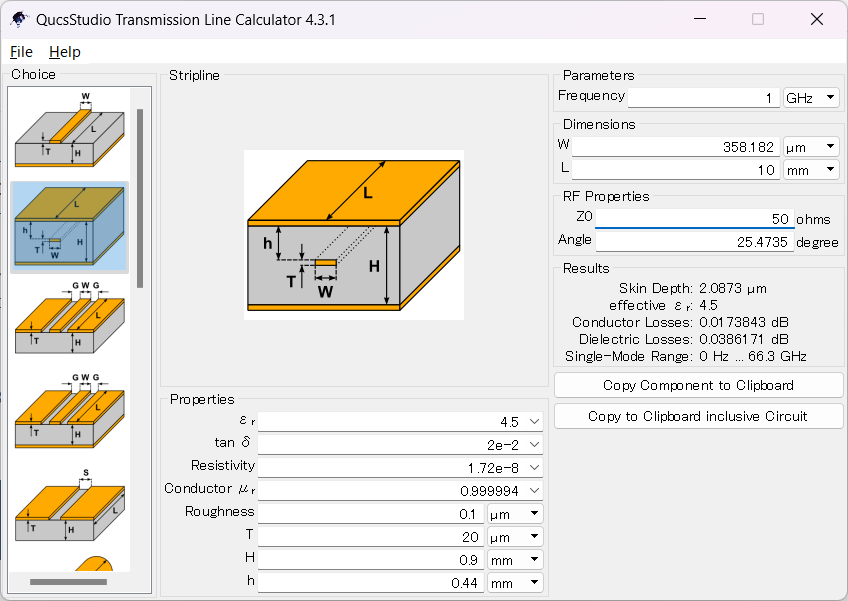One of the critical factors affecting the quality of signal transmission in PCB design is the characteristic impedance. This is especially crucial in internal transmission lines like striplines, where accurate calculation and management of their characteristic impedance are essential. This article provides a step-by-step guide on calculating the characteristic impedance of striplines using QucsStudio.
1. What is a Stripline?
A stripline consists of a conductor embedded between two ground planes. Its characteristic impedance is determined by the conductor’s width, the dielectric constant of the substrate, and the spacing between the conductor and the ground planes.
Another commonly used transmission line is the microstrip line, which differs in the following ways:
Stripline

- Structure: Composed of a conductor embedded between two ground planes.
- Advantages: High resistance to EMI (Electromagnetic Interference), suitable for high-frequency use due to less electromagnetic leakage, and more consistent characteristic impedance due to the presence of ground layers on both sides.
- Disadvantages: Tends to have higher manufacturing costs and increased design complexity.
Microstrip Line

- Structure: A structure with a conductor (trace) on one side of the substrate and a ground plane on the other.
- Advantages: Easier and cheaper to manufacture, easier access to the trace makes design and modification simpler.
- Disadvantages: Lower resistance to EMI, prone to electromagnetic leakage and signal degradation at high frequencies.
2. The Importance of Calculating Characteristic Impedance
The characteristic impedance of a stripline must be optimized to minimize signal reflection and reduce transmission loss. Improper impedance design can lead to signal degradation and loss, adversely affecting the final device’s performance.
3. Calculating Characteristic Impedance of Striplines with QucsStudio
QucsStudio provides tools that facilitate the calculation of characteristic impedance for various transmission lines, including striplines. Below, we describe the method to calculate the characteristic impedance of striplines step by step.
As an example, we will calculate the characteristic impedance of a stripline composed of the following PCB specifications using QucsStudio.

Step 1: Launching and Setting up QucsStudio
- Launch: Select Line Calculation from the ‘Tools’ menu bar in QucsStudio.
- Choosing the Type: Choose the structure ‘Stripline’ for which you want to calculate the impedance from the ‘choice’.
- Entering Necessary Parameters: Enter the parameters required for the impedance calculation here.

Step 2: Entering Substrate Information
First, enter the substrate information in Properties.
- εr: The relative permittivity of the substrate. Common FR-4 is 4.5, but this can vary based on the substrate used, so refer to the specific substrate specifications.
- tanδ: Enter the dielectric loss tangent, an indicator of electrical loss in the substrate. This number also varies with the material used. While it does not affect characteristic impedance, it impacts transmission loss, making it crucial for high-frequency signal boards.
- Resistivity: Enter the resistivity of the conductor. For copper, it is 1.72×10-8Ω. This also affects transmission loss rather than characteristic impedance.
- Conductor μr: The relative permittivity of the conductor, not the substrate. Enter the value for the conductor used.
- Roughness: The surface roughness of the conductor. High-frequency applications generally use smoother materials due to the skin effect. Enter the value according to the substrate specification. For GHz frequency ranges, it may not be as critical.
- T: The thickness of the conductor, in this case, 20um.
- H: The thickness of the dielectric, 0.9mm.
- h: The position of the conductor, 0.44mm.
Next, by entering the target frequency in the ‘Parameters’ on the top right, the preparation is complete.
Step 3: Verifying Characteristic Impedance
By entering the trace width W value in ‘Dimensions’, the corresponding characteristic impedance is calculated and displayed. Conversely, entering a value in the characteristic impedance Zo calculates and outputs the required trace width.
For this PCB, a trace width of 358um forms a stripline with a characteristic impedance of 50Ω.
4. Conclusion
Accurate calculation of the characteristic impedance of striplines is essential for achieving high-quality signal transmission. Using QucsStudio simplifies the design process and allows for more efficient derivation of optimal impedance values.



コメント